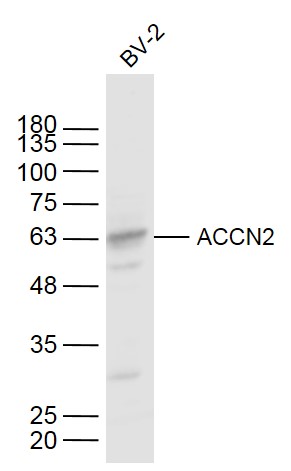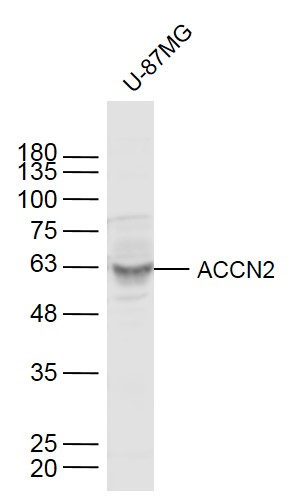
Rabbit Anti-ACCN2 antibody
ASIC1; Acid sensing ion channel 1; Acid sensing ion channel 1a protein; Acid sensing ion channel; Acid-sensing ion channel 1; AI843610; ASIC1_HUMAN; Acid-sensing ion channel 1; Amiloride-sensitive cation channel 2, neuronal; Brain sodium channel 2; BNaC2;
View History [Clear]
Details
Product Name ACCN2 Chinese Name 脑钠Channel protein2抗体 Alias ASIC1; Acid sensing ion channel 1; Acid sensing ion channel 1a protein; Acid sensing ion channel; Acid-sensing ion channel 1; AI843610; ASIC1_HUMAN; Acid-sensing ion channel 1; Amiloride-sensitive cation channel 2, neuronal; Brain sodium channel 2; BNaC2; BNAC2. literatures Research Area Neurobiology Channel protein The cell membrane受体 Immunogen Species Rabbit Clonality Polyclonal React Species Human, Mouse, (predicted: Rat, Chicken, Dog, Pig, Cow, Horse, Rabbit, Sheep, ) Applications WB=1:500-2000 ELISA=1:5000-10000
not yet tested in other applications.
optimal dilutions/concentrations should be determined by the end user.Theoretical molecular weight 60kDa Cellular localization The cell membrane Form Liquid Concentration 1mg/ml immunogen KLH conjugated synthetic peptide derived from human ACCN2: 332-460/528 <Extracellular> Lsotype IgG Purification affinity purified by Protein A Buffer Solution 0.01M TBS(pH7.4) with 1% BSA, 0.03% Proclin300 and 50% Glycerol. Storage Shipped at 4℃. Store at -20 °C for one year. Avoid repeated freeze/thaw cycles. Attention This product as supplied is intended for research use only, not for use in human, therapeutic or diagnostic applications. PubMed PubMed Product Detail Acid sensing ion channel ASIC1 is present in brain as a 4.3-kb transcript with localization to rat dorsal root ganglia. In situ hybridization of rat brain suggests that ASIC1 is most abundant in the main olfactory bulb, cerebral cortex, hippocampal formation, habenula, basolateral amygdaloid nuclei and cerebellum. ASIC1 and H+-gated currents may contribute to the development of fear and anxiety. ASIC2, also designated amiloride-sensitive cation channel 1, neuronal (ACCN1), mammalian degenerin, BNAC1 (MDEG) and brain Na+ channel 1, mediates the normal detection of light touch. ASIC2 mRNA is abundant in brain, specifically in neurons. ASIC2 is expressed as 2.7- and 3.7-kb transcripts in brain and spinal cord tissues. ASIC3, also designated SLNAC1 and TNaC1, mediates detection of lasting pH changes and is involved in modulating moderate- to high-intensity pain sensation. ASIC4, also designated ACCN4 and BNAC4, is abundant in pituitary gland and is also present in the inner ear.
Function:
Cation channel with high affinity for sodium, which is gated by extracellular protons and inhibited by the diuretic amiloride. Also permeable for Ca(2+), Li(+) and K(+). Generates a biphasic current with a fast inactivating and a slow sustained phase. Mediates glutamate-independent Ca(2+) entry into neurons upon acidosis. This Ca(2+) overloading is toxic for cortical neurons and may be in part responsible for ischemic brain injury. Heteromeric channel assembly seems to modulate channel properties. Functions as a postsynaptic proton receptor that influences intracellular Ca(2+) concentration and calmodulin-dependent protein kinase II phosphorylation and thereby the density of dendritic spines. Modulates activity in the circuits underlying innate fear.
Subunit:
Homotrimer or heterotrimer with other ASIC proteins. Interacts with STOM and ASIC2. Interacts with PRKCABP.
Subcellular Location:
Cell membrane. Localizes in synaptosomes at dendritic synapses of neurons. Colocalizes with DLG4.
Tissue Specificity:
Expressed in most or all neurons.
Post-translational modifications:
Phosphorylation by PKA regulates interaction with PRKCABP and subcellular location. Phosphorylation by PKC may regulate the channel.
Similarity:
Belongs to the amiloride-sensitive sodium channel (TC 1.A.6) family.
ACCN2 subfamily.
SWISS:
P78348
Gene ID:
41
Database links:Entrez Gene: 41 Human
Entrez Gene: 11419 Mouse
Omim: 602866 Human
SwissProt: P78348 Human
SwissProt: Q6NXK8 Mouse
Unigene: 274361 Human
Unigene: 440107 Mouse
Unigene: 37385 Rat
Product Picture
BV-2(Mouse) Cell Lysate at 40 ug
Primary: Anti-ACCN2 (SL12128R) at 1/300 dilution
Secondary: IRDye800CW Goat Anti-Rabbit IgG at 1/20000 dilution
Predicted band size: 60 kD
Observed band size: 60 kD
Bought notes(bought amounts latest0)
No one bought this product
User Comment(Total0User Comment Num)
- No comment




 +86 571 56623320
+86 571 56623320
 +86 18668110335
+86 18668110335

